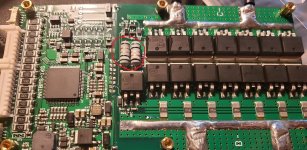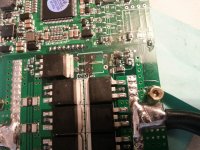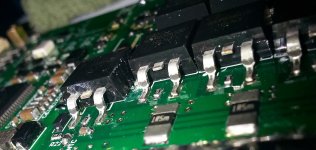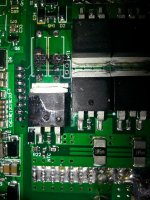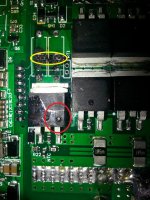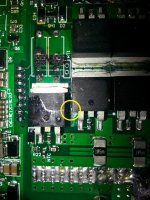pwd said:
There is a marking on the board near the resistors that appears to say "RT1".
That's for the pads next to the marking, for a thermistor, a temperature sensing resistor, probably specifically to sense the temperature of those resistors and the FET next to them, specifically to prevent this sort of problem, but omitted from the design because it saves a few cents and the board "works" without it, at least until whatever occurs that causes the overheating condition.
If you knew what type of thermistor was designed to go there, you could add it, and the software may have the function still in there (just disabled by default), or it could be a hardware-only function, whcih may require other components elsewhere on teh board that may or may not be populated.
The resistors (or whatever they may be) are in even worse shape on the underside. One measures ~ 55K-65K ohms and the other is jumping around 200K-250K ohms (I can't seen to get a solid reading on either).
Neither is very surprising--severe overheating can destroy the component, or just damage the resistive (or inductive, etc) element, *or* just damage the interconnects between the element and the ends. And the heating is worse on the bottom because it's trapped and reflected by the PCB surface and traces underneath it.
for the record, the board was working fine until some water hit the board.
"some water"? Specifics and details may help determine the cause of the fault and let you fix it (though no guarantees).
FWIW, if I had this probelm, and had any choice (could use the pack without it till I could replace it or coudl use a different pack) I wouldn't even continue using it if it had water damage, especially if it caused a fault with it. You don't know what hidden damage (corrosion, etc) that may be lurking in PTHs and under SMT components, waiting to cause a fault that kills your pack or leaves you stranded.
If the pack itself also had water damage, I'd consider the entire thing suspect and keep a very close eye on it forever, even if you can't *see* anything wrong now.
Last time I plugged it pack into the pack; the pack voltage was correct but it said something like "discharge mosfet abnormality".
You'd have to trace it out, but I'd guess that those resistors are in series with the discharge FETs, being used as some form of shunt resistor for current sensing. If they are instead supposed to be gate resistors, then if they got that hot there's something wrong with the drive circuitry too.

